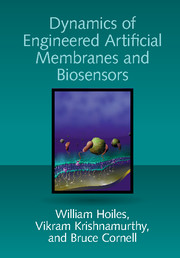Book contents
- Frontmatter
- Contents
- Preface
- List of Abbreviations
- Part I Introduction and Background
- 1 Motivation and Outline
- 2 Biochemistry for Engineers: A Short Primer
- 3 Engineered Artificial Membranes
- Part II Building Engineered Membranes, Devices, and Experimental Results
- Part III Dynamic Models for Artificial Membranes: From Atoms to Device
- Appendices
- Bibliography
- Index
3 - Engineered Artificial Membranes
from Part I - Introduction and Background
Published online by Cambridge University Press: 25 May 2018
- Frontmatter
- Contents
- Preface
- List of Abbreviations
- Part I Introduction and Background
- 1 Motivation and Outline
- 2 Biochemistry for Engineers: A Short Primer
- 3 Engineered Artificial Membranes
- Part II Building Engineered Membranes, Devices, and Experimental Results
- Part III Dynamic Models for Artificial Membranes: From Atoms to Device
- Appendices
- Bibliography
- Index
Summary
Membranes
Biological membranes are ubiquitous, ranging from the cell membrane which encompasses a cell, to membranes for organelles within the cell such as the nucleus and mitochondria. This book focuses exclusively on the construction and modeling of engineered artificial membranes. We use the term “engineered membranes” to emphasize the fact that we will precisely engineer various components of the artificial membrane to achieve specific structural properties. Additionally, we model the dynamics of these engineered membranes from atoms to device. The results from artificial membranes elucidate the structural and dynamic properties of biological membranes. The interaction of biological membranes with macromolecules is key to the fight against human disease (rational drug design and construction of therapeutic protocols). As such, engineered artificial membranes in combination with accurate mathematical models provide an important tool for innovation in the pharmaceutical industry.
Since artificial membranes are meant to mimic biological membranes, we start by discussing the key properties of one of the most important biological membranes, namely, the cell membrane. The cell membrane provides an interface between the cell and its environment as illustrated in Figure 3.1. The extracellular fluid (depicted in Figure 3.1) contains all components that are not contained in the cell, and the cytosol is composed of components that are contained in the cell. Cell membranes are dynamic and respond to their environment as the result of an external stimulus. To recap from Chapter 2, the cell membrane is composed of three primary components:
(i) Lipids. Lipids are primary components of the cell membrane. All lipids are composed of a hydrophilic head (attracted to water) and hydrophobic tails (water neutral). The lipids separate the extracellular fluid from the cytosol of the cell.
(ii) Macromolecules. These are responsible for cellular communication both in cells and between cells. Given the low permeability of biological membranes, the primary task of macromolecules is to transport molecules from the extracellular fluid to the interior of the cell. Additionally, there exist other macromolecules which act as molecular receptors, detect vesicles carrying cellular cargo, and facilitate the transport of other macromolecules across the membrane from the extracellular fluid to the cytosol, or from the cytosol to the extracellular fluid.
- Type
- Chapter
- Information
- Publisher: Cambridge University PressPrint publication year: 2018



